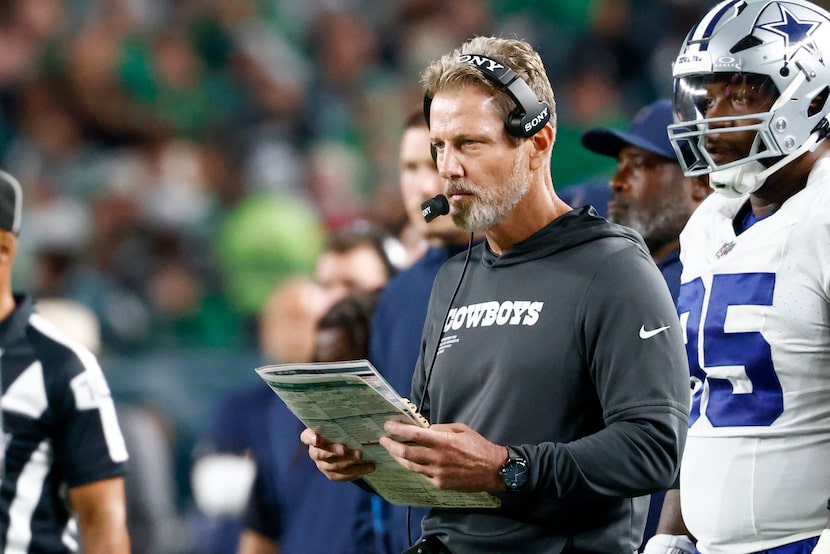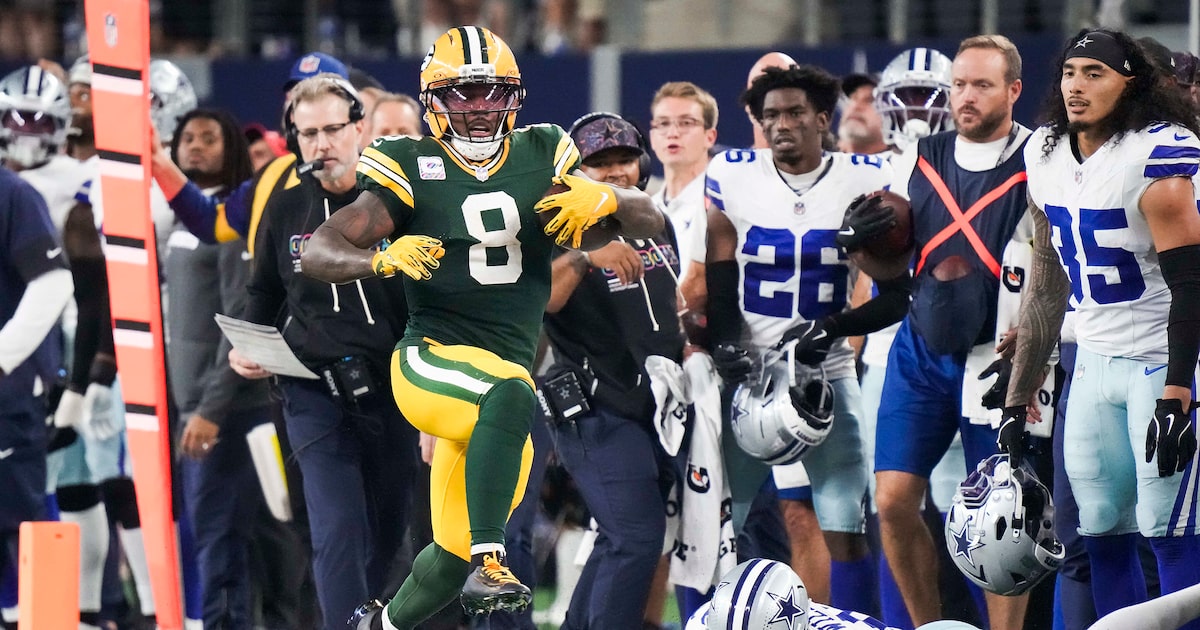FRISCO — Wade Phillips sits in a golf cart at a charity event in Houston and talks about installing new defensive schemes.
Dave Campo relaxes at his Fort Worth-area home and discusses his experiences in changing defenses.
The former defensive-minded Cowboys coaches advise making the switch immediately when taking over for a new team, but they also understand waiting, something both have done. And both stress the importance of tailoring the scheme to the players.
Seeking the insight from Phillips and Campo came to mind after what’s happened with the Cowboys’ defense in the first six weeks of the season.
Cowboys
Under new coordinator Matt Eberflus, the Cowboys’ defense is among the worst in the league.
Eberflus is the Cowboys’ third defensive coordinator in as many years. He’s switching from a 4-3 attack front with some zone and man-to-man principles to a 4-3 front with heavy zone coverages.

Dallas Cowboys defensive coordinator Matt Eberflus watches during the second half of an NFL game against the Philadelphia Eagles, Thursday, Sept. 4, 2025, in Philadelphia. The Eagles defeated the Cowboys 24-20.
Elías Valverde II / Staff Photographer
It’s been met with poor results as the Cowboys enter their Week 7 contest against the Washington Commanders on Sunday at AT&T Stadium. The Commanders’ defense is partially engineered by Dan Quinn, the Cowboys’ defensive coordinator for three seasons and the last to have success.
As it stands, the Cowboys have the worst-ranked defense in the NFL. They’ve allowed an NFL-high 15 passing touchdowns. And despite collecting 11 sacks, five came in a victory over the 0-6 New York Jets.
Star cornerback Trevon Diggs said the defense has no identity. Team owner Jerry Jones and coach Brian Schottenheimer offered support this week for Eberflus and his scheme.
However, Schottenheimer said changes are coming. Maybe more man-to-man. Maybe more blitzes. Maybe personnel.
Whatever the changes, more positive results are needed.
Players over scheme
Cowboys coaches Brian Stewart (left), Wade Phillips (center) and Dave Campo (right) are shown on the sideline during second half NFL football action between the Dallas Cowboys and the Tampa Bay Buccaneers at Texas Stadium in Irving. Dallas won 13-9.
JOHN F. RHODES / 135941
Phillips has been there numerous times. New Orleans. Denver. Dallas. Houston. Los Angeles Rams.
“Did it quite a few times, so I was used to doing it,” the former Cowboys head coach said about switching schemes.
Phillips is known for coaching a 3-4 scheme with man-to-man coverage. He’s switched defenses from 4-3 fronts to 3-4.
“The No. 1 thing is the pass rush to cut down the passing game,” he said. “Whether it’s sacks or pressures or whatever it is. That’s why I always like the 3-4 better.”
When Phillips was hired in 2007 to replace Bill Parcells, he switched the Cowboys from what he called “the Giants 3-4” to his 3-4 alignment. Parcells, a former Giants head coach and defensive coordinator, would drop pass rushers into coverage from time to time, and he wanted bigger players along the line of scrimmage.
Phillips didn’t mind the big players, he just wanted his pass rushers to get after the quarterback, so that’s where DeMarcus Ware fit. Ware compiled 19½ sacks in the 2005 and 2006 seasons under the Parcells version of the 3-4.
Phillips didn’t go for a total rebuild of the defense in his first year. It took until that second year (2008) for him to fully implement his defense. Ware had 20 sacks that season and was named to his first Pro Bowl and All-Pro teams.
“It’s still about getting your best players the opportunity to do what they do well,” Phillips said. “You didn’t want DeMarcus dropping all the time, which he had to do in their scheme. The players are more important than the scheme. Everybody has their own scheme, but you got to be able to put the players in position to make plays, things they can do. If they’re really good at something, you got to utilize that.”
Cowboys cornerbacks Diggs and DaRon Bland compiled Pro Bowl and All-Pro berths between 2021 and 2023 along with 28 interceptions playing primarily man-to-man under Quinn’s scheme.
Quinn was hired in 2021 to replace Mike Nolan as defensive coordinator. In the 2020 season, Nolan’s defense allowed a franchise-record 473 points in a 4-3 scheme that was more of a read-and-react style with some zone principles.
Quinn changed that in 2021, sticking with a 4-3 front but also playing more man-to-man. What also helped Quinn was dynamic pass rusher Micah Parsons. The pressure Parsons placed on quarterbacks allowed Quinn to have his corners play more man-to-man.
Mike Zimmer was hired to replace Quinn when he left to become the head coach in Washington in 2024.
Zimmer, a former Cowboys defensive coordinator, tried to keep some of Quinn’s principles, but as the season progressed he used more of his own scheme. Zimmer admitted he should have started the 2024 season using his own scheme. Zimmer said he saw the success of Quinn’s defense and didn’t want to mess with a good thing.
But the Cowboys finished 28th in total defense and 31st in points allowed. Zimmer, who had signed a one-year deal, didn’t return, which brought in Eberflus, a former Cowboys linebackers coach who was a defensive coordinator in Indianapolis and head coach in Chicago.
Better to wait?
Dallas Cowboys secondary coach Dave Campo talks with Cincinnati Bengals defensive coordinator Mike Zimmer before the start of the Pro Football Hall of Fame game at Fawcett Stadium in Canton, Ohio, on August 8, 2010.
VERNON BRYANT/Staff Photographer
Eberflus had two options: He could have kept some of Zimmer’s or Quinn’s schemes or implement his own. Eberflus opted for a scheme the Cowboys have used in the past, a 4-3 zone front with little blitzing. It’s a scheme used under previous defensive coordinator Rod Marinelli.
Some coaches wait a year to use their own scheme because of the transition period it takes for players to learn it. Campo said he did exactly that when he took over for Butch Davis in the 1995 season.
“It’s not easy because you draft certain personnel and when you’re drafting for a personnel to a 4-3 it’s different than drafting for a team with a 3-4,” he said. “You got defensive ends in a 4-3 that are bigger and more physical. In a 3-4, a linebacker is on the edges. I’m more inclined, I wouldn’t change the defense in the first year.”
After the Cowboys won the Super Bowl in the 1995 season, Campo switched how he played his 4-3 defensive scheme. Campo said Davis didn’t like switching defensive ends, but in his scheme he flipped them. It allowed pass rushers such as Charles Haley to avoid double-teams. Under the Davis scheme, Haley would get chipped by a tight end or a running back and it eventually wore him down during the course of a season.
Campo, who was head coach of the Cowboys from 2000-02, said making adjustments to suit personnel, regardless of scheme, is most important.
The same applies to the offense.
The Cowboys’ offensive line maintains a blocking scheme they’ve used in the past. Without getting into specifics, right tackle Terence Steele said it’s been a benefit.
“This current coaching staff did a real good job of knowing what our strengths are as an offensive line,” Steele said.
In 2024, the Cowboys used inside zone cuts and more gap schemes to block. They are doing similar things this season with a new offensive coordinator, Klayton Adams, and offensive line coach, Conor Riley.
“Each coach has their intricacies of how they want something blocked,” Steele said. “Or where they want your hand fits or just little stuff like that. But for the most part, it’s all been the same.”
Challenge for players
Dallas linebacker Greg Ellis is pictured in the first quarter in Dallas’ 31-22 win over the Bengals on Oct. 5, 2008.
LOUIS DeLUCA / 135417
Is switching schemes difficult for players?
Defensive tackle Kenny Clark played a majority of his career in a 3-4 scheme in Green Bay. Last season, the Packers switched schemes to what the Cowboys play now in the 4-3.
So when the Cowboys traded Micah Parsons to Green Bay for two first-round picks and Clark, they were getting a player familiar with Eberflus’ scheme.
“It’s different,” he said of the scheme he’s played in the last two seasons. “But from what I remember, the Cowboys have always been an attack front, 4-3, where [Zimmer] got here they were still an attack front but a little read and react defense.”
Greg Ellis switched defensive positions as a player and had a full scheme change as a coach.
When he played for the Cowboys, he was drafted as a defensive end but when Parcells became the coach he was too small to play edge in that 3-4 scheme. So Parcells moved him to outside linebacker.
“I was still playing defensive end at 270-275 pounds against 350-pound tackles,” Ellis said. “It’s going to be a challenge but that was my position. But Bill realized, ‘Greg is tough and he’s going to give all he can do.’ I was in more pass rush situations but then he switched me to outside linebacker in training camp (2004) and the rest was history and it worked out for me because playing outside linebacker fit my body type.”
Success can be found by moving players to fit a scheme. Sometimes changing the scheme comes with challenges. In Quinn’s scheme, the defensive front was asked to attack the quarterback. Zimmer’s scheme asked the defensive linemen to do what Ellis called “attack the V of the neck and get up the field.”
Attack the V means to go through the defender instead of going through a gap or attacking the edge of the offensive line.
Ellis, who was an assistant defensive line coach with the Cowboys last season, said totally changing schemes can be difficult.
“It’s harder for a player,” said Ellis, who played in 12 NFL seasons, 11 with the Cowboys. “Again, as coaches, if you’re on top of your game, it’s like you have hours to be contemplating, thinking about it right, and now the challenge is to make sure you are delivering it to the guys in a way they can pick it up as quickly as possible. It’s a huge responsibility on the players as well. They have to take the ownership to be successful or that contributes to its demise or failing as well.”
While some of the Cowboys’ players would like to play more man-to-man and blitz more, there has to be confidence that it will work from coaches and players.
Eberflus wants to do all of this, but understands you can only do so much with the personnel at your disposal.
“You like to play man, but if you can’t play man, great man, then you got to play some kind of match zone,” Phillips said. “It’s hard to compete against man-to-man, but match zone, and zone [blitz] those all fit into your defense.”
Campo knows Eberflus well. They worked together in 2011, Campo as the Cowboys’ secondary coach and Eberflus as the linebacker coach. Both know the pressures that come in trying to achieve success.
When the results don’t work, change happens. Over the past seven years, the Cowboys have employed five different defensive coordinators.
“I wouldn’t be surprised if they’re a much better defense a year from now. If he makes it through, cause everybody is trying to run him out of here,” Campo said of Eberflus. “I’ve been there, too, so I know exactly what that’s all about. To me, it’s a real difficult task.”
Find more Cowboys coverage from The Dallas Morning News here.

